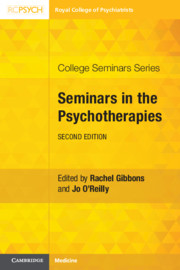Book contents
- Seminars in the Psychotherapies
- College Seminars Series
- Seminars in the Psychotherapies
- Copyright page
- Reviews
- Contents
- Contributors
- Foreword
- Preface
- Part I Therapy Theory and Practice
- Section 1 Psychodynamic Psychotherapy
- Chapter 1 Psychodynamic Theory: The Development of a Model of the Mind
- Chapter 2 A Psychodynamic Approach to Psychiatry
- Chapter 3 Referral for Psychodynamic Psychotherapy: Processes and Considerations
- Chapter 4 Psychodynamic Psychotherapy: The Consultation Process
- Chapter 5 Psychological Models for Case Formulation
- Chapter 6 Psychodynamic Psychotherapy Practice: An Introduction
- Section 2 Other Forms of Psychotherapy
- Part II Applied Psychotherapeutic Thinking
- Index
- References
Chapter 1 - Psychodynamic Theory: The Development of a Model of the Mind
from Section 1 - Psychodynamic Psychotherapy
Published online by Cambridge University Press: 27 May 2021
- Seminars in the Psychotherapies
- College Seminars Series
- Seminars in the Psychotherapies
- Copyright page
- Reviews
- Contents
- Contributors
- Foreword
- Preface
- Part I Therapy Theory and Practice
- Section 1 Psychodynamic Psychotherapy
- Chapter 1 Psychodynamic Theory: The Development of a Model of the Mind
- Chapter 2 A Psychodynamic Approach to Psychiatry
- Chapter 3 Referral for Psychodynamic Psychotherapy: Processes and Considerations
- Chapter 4 Psychodynamic Psychotherapy: The Consultation Process
- Chapter 5 Psychological Models for Case Formulation
- Chapter 6 Psychodynamic Psychotherapy Practice: An Introduction
- Section 2 Other Forms of Psychotherapy
- Part II Applied Psychotherapeutic Thinking
- Index
- References
Summary
The practice of psychiatry and the development of psychological treatments rest upon how we understand the mind and emotional life. As clinicians working with patients with difficulties in how they feel, relate and think we need an understanding of psychic life in healthy and more disturbed states, just as practitioners of physical medicine need to understand bodily processes in sickness and in health.
- Type
- Chapter
- Information
- Seminars in the Psychotherapies , pp. 3 - 20Publisher: Cambridge University PressPrint publication year: 2021
References
- 1
- Cited by



